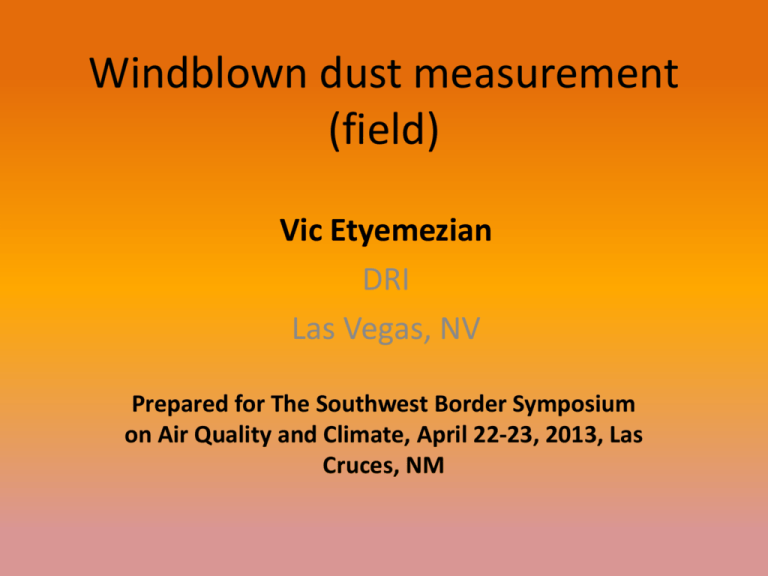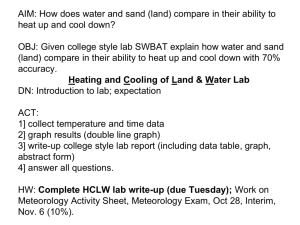Windblown Dust Measurement (Field)
advertisement

Windblown dust measurement (field) Vic Etyemezian DRI Las Vegas, NV Prepared for The Southwest Border Symposium on Air Quality and Climate, April 22-23, 2013, Las Cruces, NM Outline • • • • Introduction Overview of mechanism Direct measurement Inferential measurement (using sand as a surrogate) • Wind tunnel measurement • Soil condition considerations • Roughness considerations Windblown dust (WBD) • Among largest sources of atmospheric aerosol (about 1,000 terragrams or 1 billion tons per year) • Mostly natural (75%, Ginoux et al., 2012) and significant fraction (30%, Ginoux et al., 2012) related to hydrologic processes. • Largely from African continent, but all nonpolar continents have significant dust sources Ginoux, P., J. M. Prospero, T. E. Gill, N. C. Hsu, and M. Zhao (2012), Global-scale attribution of anthropogenic and natural dust sources and their emission rates based on MODIS Deep Blue aerosol products, Rev. Geophys., 50, RG3005, doi:10.1029/2012RG000388. Scales • Global(104 km) /Continental (103 km)/Regional (102 km)/ Local (10 km) – Remote sensing – Models (e.g. NAAPS, http://www.nrlmry.navy.mil/aerosol/ ) • Local (10 km)/ Field (1 km) – Remote sensing – source identification tricky – Models – inhomogeneous terrain and parameter specification tricky – On-site measurements can provide useful information Mechanisms of Windblown Dust Suspension • Creep 0.5 - 2 mm particles roll due to pressure differential • Saltation 0.1 - 0.5 mm particles suspended, travel parallel to ground 1-5 m, re-impact Cause release of additional particles • Emission 0.001 - 0.1 mm particles suspended and transported between 10 – 10,000 m Mechanisms of dust emission http://www.weru.ksu.edu/ Direct measurement of WBD • Dale A. Gillette (DAG) largely championed approach – Measure profile of wind speed and dust concentration during WBD event – Use theoretical considerations to calculate upward flux of dust – In practice, DAG used sand flux as surrogate for dust concentration for measurement ease • Advantage: Defensible measure of emissions under real-world conditions • Disadvantage: Requires substantial field infrastructure and presence during dust event(s); assumes homogeneous source strength Inference from sand flux • Saltation (sand ballistic impacts on soil) is primary means of emitting dust • The amount of sand that is carried across a line should relate to the amount of dust that has been emitted from the surface • In some instances, dust emission is assumed proportional to sand flux (e.g., Gillette et al., 2004) Gillette, D.A., Ono, D. and Richmond, K. 2004. A combined modeling and measurement technique for estimating windblown dust emissions at Owens (dry) Lake, California. Journal of Geophysical Research. Earth Surface 109, F01003, doi:10.1029/2003JF000025 Sand flux • Integrated samplers (e.g., BSNE, Cox sand catcher) – Reliable, inexpensive, does the job, provides physical sample – No time resolution, labor-intensive Sand flux (cont.) • Electronic sensors (e.g., saltiphone, SensitTM, Safire, Wenglor, other optical gate sensors) – Vibration/sound – Extinction/optical gate – Advantages: Time resolution for linking with wind conditions – Disadvantages: No physical sample, sensitivity issues, requires electronic infrastructure Sand Flux (cont.) • NSF-funded project to develop new real-time sensor using optical gate technology • Includes WS/WD, T, Sand sensor + trap, power source, data logger w/ memory card • Promising for sand sizing as well as mass In-situ measurement of WBD potential • Conduct measurements in field using wind tunnel or similar technology – Identify soil/landform characteristics that can be grouped – Conduct erodibility measurements to obtain response of soil to wind stress – Use range of results to estimate response of soil/landform – Apply other corrections for weather, soil conditions, and surface cover Field wind tunnels • To obey fluid and saltation scaling laws, wind tunnel must be large Field wind tunnels (cont.) • Advantages: – No need to wait for dust – Can examine subsets of landscape, soil conditions, wind strengths, treatment efficacy (if applicable) • Disadvantages – So much land, so little wind tunnel – Labor intensive (4-8 hours per measurement) – Finite length can deplete erodible portion • Despite scaling compliance, ability to quantify saltation effect questionable • Addition of “external” sand source results in undue sandblasting – Can only examine subsets of landscape, soil conditions, wind strengths, treatment efficacy (if applicable) PI-SWERL • Portable In-Situ Wind ERosion Lab (PI-SWERL) • Like a wind tunnel – But not • Does not comply with scaling laws • Motivated by need for portable measure of wind erodibility where wind tunnels are not practical Concept • Use flat plate to generate shear stress • Use circular shape to get steady conditions (axisymmetric flow) Plate moving with respect to ground Velocity gradient results in shear at ground, suspending loose particles Ground Various versions Current version Miniature PI-SWERL (MPS-2) Mini PI-SWERL 1.1 1 Friction Speed: 0.9 y = -1E-12x3 + 8E-09x2 + 0.0001x + 0.0872 0.9 R2 = 0.9998 0.8 0.8 0.7 Shear u* Poly. (u*) Poly. (Shear) 0.7 0.6 0.5 0.6 0.5 0.4 0.4 0.3 0.3 Shear: 3 0.2 2 y = -4E-12x + 5E-08x - 2E-05x + 0.0351 0.2 R2 = 0.9999 0.1 0.1 Mini_Swirler_RPM 6800 6400 6000 5600 5200 4800 4400 4000 3600 3200 2800 2400 2000 1600 800 1200 400 0 0 0 u* (m/s) 1 Shear stress (Pa) • 30 cm diameter • Rotates up to 6000 RPM or approximately u*=1 m/s or WS 60 mph • Use DustTrak (8520 or 8530) to estimate PM10 concentrations • Uses optical gate sensors to detect and quantify sand motion (not quite sand flux) • “clean” air is pumped into chamber • “dirty” air is exhausted • Emissions potential can be estimated at varying shear stresses How does soil respond to shear stress OGS_Count_2 OGS_Count_3 OGS_Count_4 DT_PM10(mg/m3) Flowrate (LPM) 2000 RPM or u* = 0.39 m/s 700 600 500 400 300 200 140 120 100 OGS2 and OGS4 are saturated 80 60 40 20 100 0 0 0 100 200 400 300 Seconds into test 500 600 700 DustTRak PM10 (mg/m3) or Flowrate (LPM) OGS_Count_1 1000 RPM or u* = 0.24 m/s RPM/10 or OGS counts/second 800 TRPM/10 4000 RPM or u* = 0.69 m/s 900 RPM/10 3000 RPM or u* = 0.55 m/s 1000 How else? 10 9 8 7 6 5 4 3 2 1 0 4500 PM10 or OGS peak area PM10 concentration (mg/m3) OGS Sensor 1 (peak area) OGS Sensor 2 (peak area) Target RPM 4000 3500 3000 2500 2000 1500 1000 500 0 100 200 300 400 Test Duration (s) 500 0 600 Useful for understanding differences 100 10 Burn 9MAB 12MAB 21 MAB 24 MAB 33 MAB 1 Burned-US Burned-IS 0.1 Control Emissions relative to control 1000 Confounding factors 1 • Wind tunnel measurements are point-in-time measurements. Do not account for: – Soil moisture – Temperature – Soil crusting – Disturbance level • Need to account for these – Robust measurement plan – Corrections after the fact Confounding Factors 2 • Surface cover – WT is placed over bare or light vegetation – PI-SWERL only on very light vegetation – Both directly include accounting for gravel – Vegetation + large scale roughness – trickier • Techniques available (e.g., Raupach ,1992) • Imperfect Raupach, M.R. 1992. Drag and drag partitioning on rough surfaces. Boundary-Layer Meteorology 60(4):375-395. Confounding Vegetation! 1. u* measured here 2. ut* measured here 3. Does soil surface experience u*? Thanks! Questions? Collocation/calibration 100 . Non Gravel Surfaces Gravel Surfaces Saltation Above 100 mg/ms 1 All Data: R=0.76, b=1.0, a=0.02 Non Gravel Surfaces: R = 0.75, b=1.13, a=0.17 Gravel Surfaces: R=0.85, b=0.81, a=-0.35 0.1 Saltation above 100 mg/ms: R=0.81, b=0.94, a=-0.15 0.01 100 10 0.0001 0.0001 Y =(0.57 0.08) X (0.77 0.05) 2 0.001 Wind Tunnel PM10 Emissions (mg/m s) -2 -1 Wind Tunnel PM 10 Emissions (mg.m s ) 10 0.001 0.01 0.1 1 10 100 1 0.1 0.01 PI-SWERL PM10 Emissions (mg.m-2s-1) 0.001 0.001 0.01 0.1 1 10 2 PI-SWERL PM10 Emissions (mg/m s) 100 Shear stress 1.2 S-0 S-400 S-800 S-1200 S-1600 S-2000 S-2400 S-2800 S-3200 S-3600 S-4000 S-4400 S-4800 S-5200 S-5600 S-6000 S-6400 1 Shear Stress (Pa) 0.8 0.6 0.4 0.2 0 -7 -2 3 8 13 18

